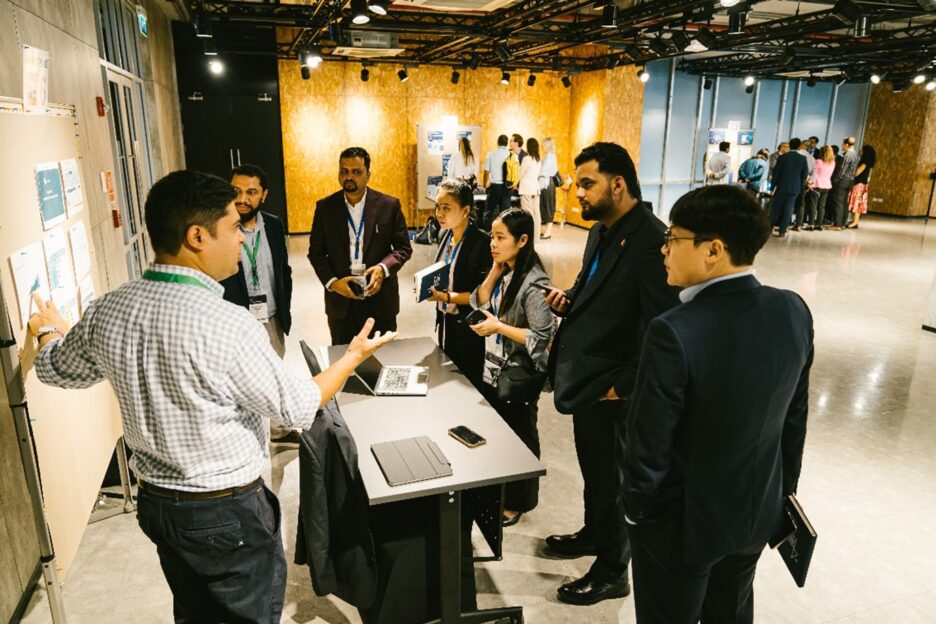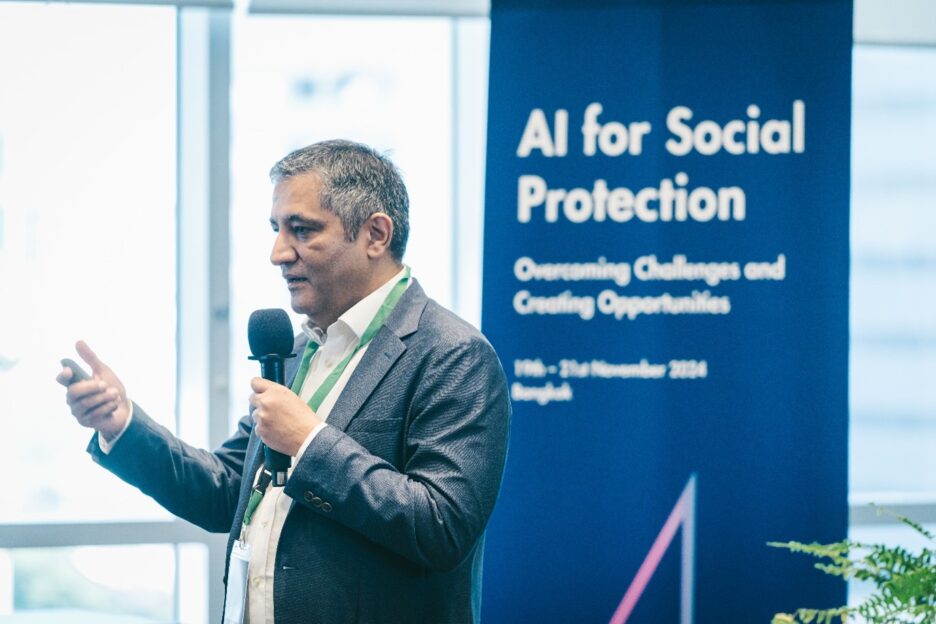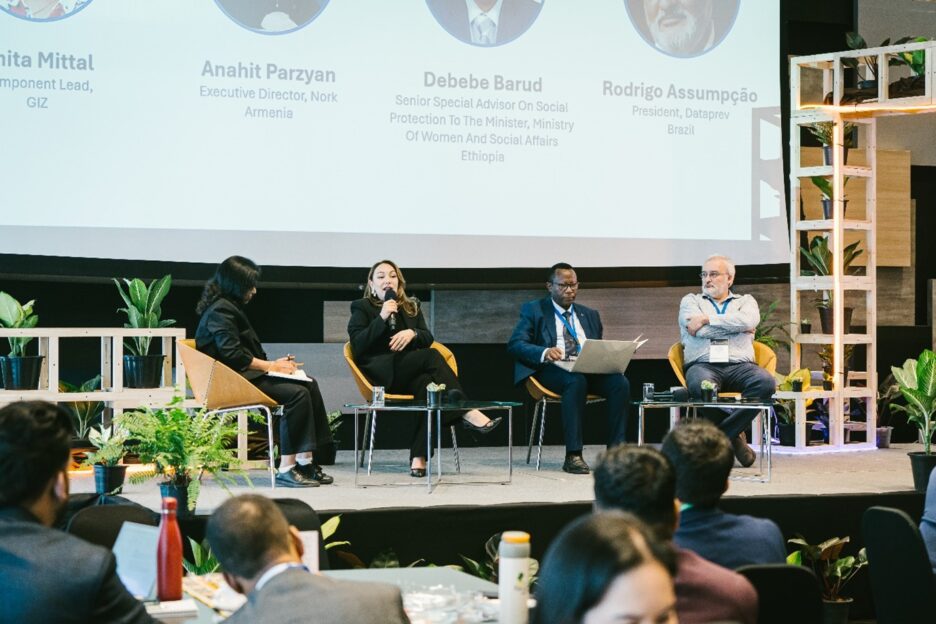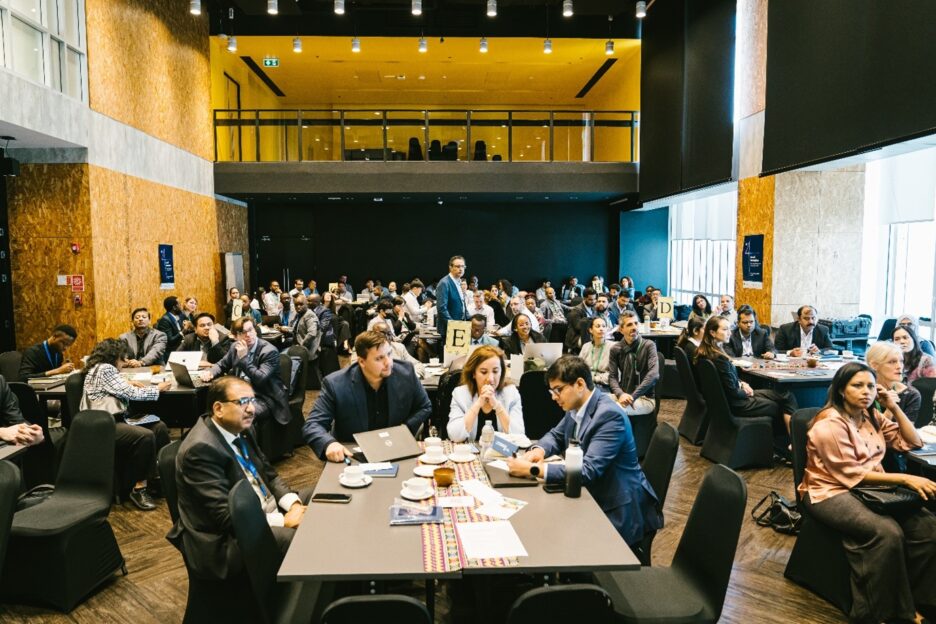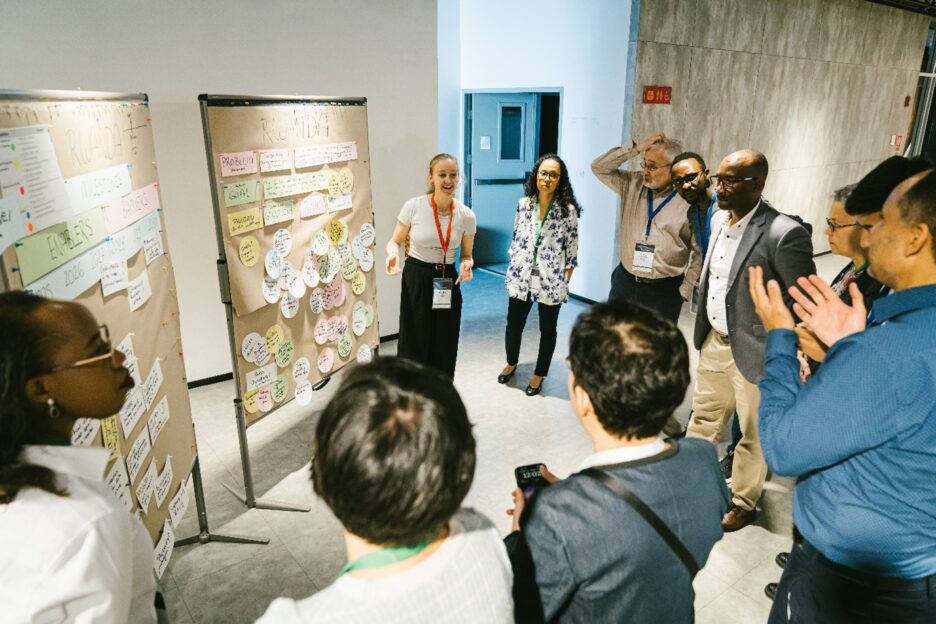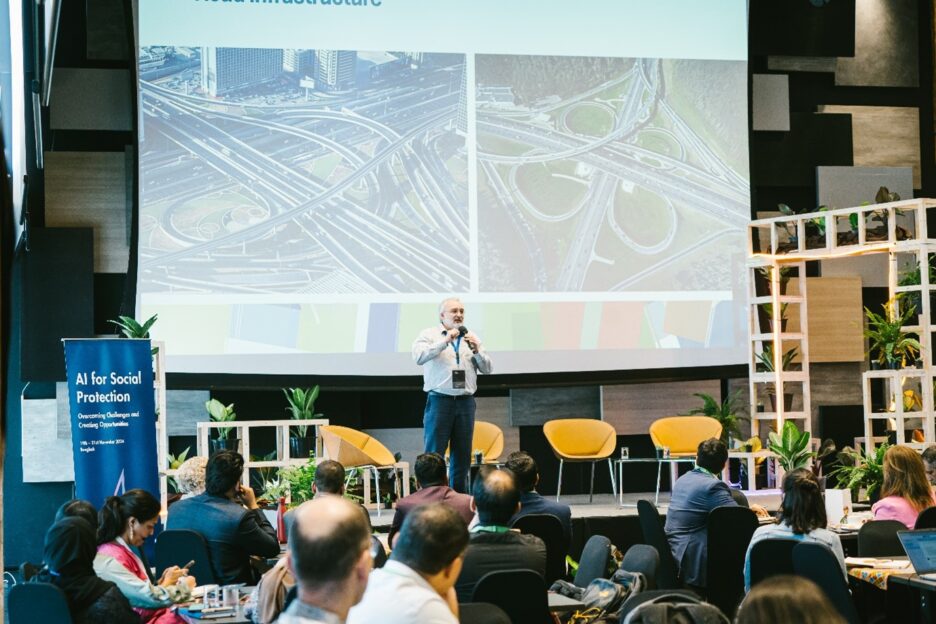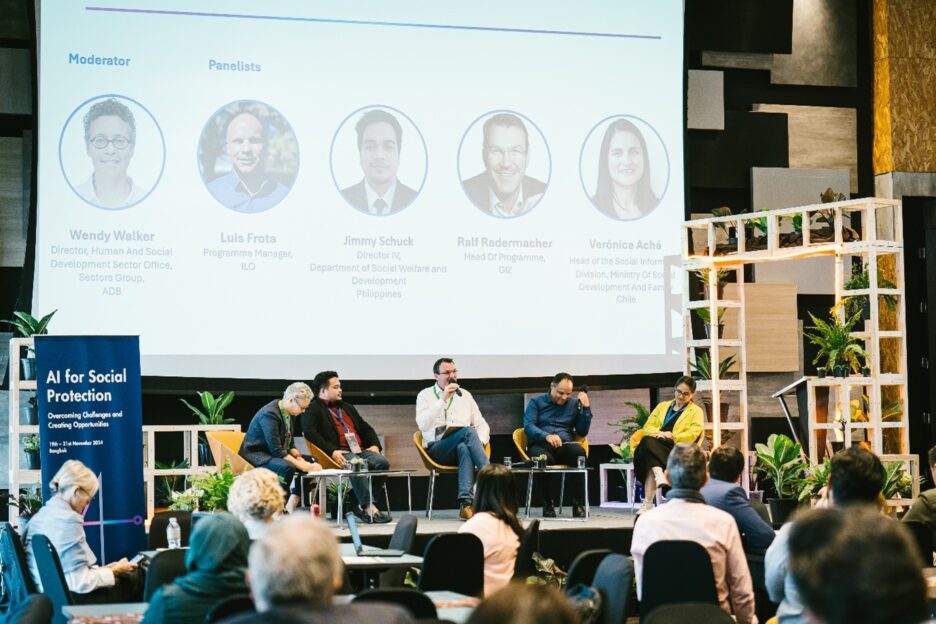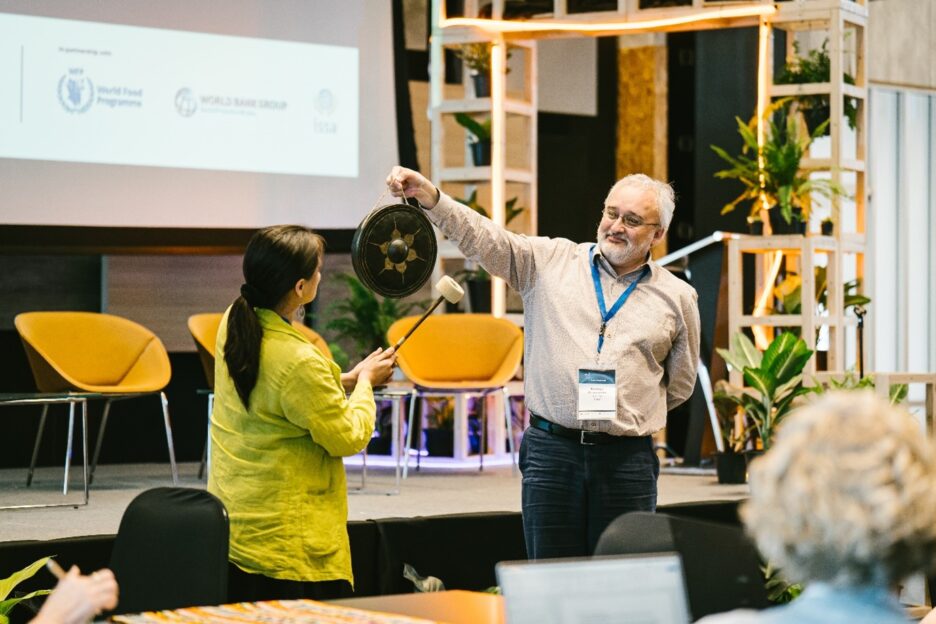AI in social protection – now and tomorrow
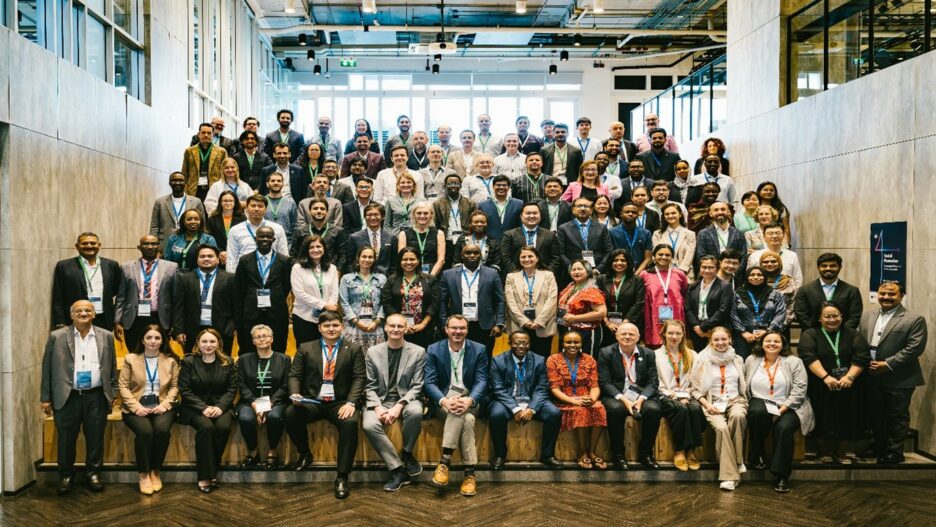
This blog was originally published in January 2025 on socialprotection.org.
Where can AI generate the biggest benefits for social protection systems? What are the challenges and risks? And what’s the way forward? A three-day workshop in Bangkok in November 2024 brought together participants from around the world to brainstorm these and other questions.
We stand at the brink of an AI revolution in social protection,’ said Hon Mohamed Rahman Swaray, Minister for Employment, Labour and Social Security in Sierra Leone. He was speaking at the close of the three-day workshop AI4SocialProtection – Overcoming Challenges and Creating Opportunities, held at the KX Knowledge Center in Bangkok from 19 to 21 November 2024.
This event saw social protection experts, policymakers, country representatives, technology specialists, and AI software providers from around the world gather to brainstorm opportunities to harness AI’s transformative potential in social protection, share stories about how AI has already been used, and voice their concerns about the risks and challenges.
The event was co-funded by the German Federal Ministry for Economic Cooperation & Development (BMZ), the European Commission, and the Asian Development Bank (ADB) and co-hosted by Deutsche Gesellschaft für Internationale Zusammenarbeit GmbH (GIZ), the Digital Convergence Initiative (DCI), and ADB, in partnership with the World Food Programme (WFP), the World Bank (WB), and the International Social Security Association (ISSA).
A creative mix of discussion formats
This was a highly collaborative gathering which used a variety of formats to stimulate discussion, encourage problem-solving, and enable participants to share their different experiences. In addition to keynotes and panel discussions, other formats included:
- Pecha Kucha presentations – six speakers from different countries gave engaging presentations of seven minutes each on the use of AI solutions in their respective countries.
- An ‘unconferencing’ session – delegates proposed topics that they particularly wanted to discuss with other delegates. A total of 24 guided discussions of about 15 minutes each were then held. Each proposer facilitated the discussion about ‘their’ topic with break-out groups from the wider audience.
- A marketplace session – this gave participants the chance to talk directly to ten solution providers, including the private sector and international organisations, with innovative AI solutions already on the market. The providers gave break-out audiences a mini-presentation and took audience questions.
- A co-creation process – this peer-assist approach sought to harness the knowledge and insights of delegates to solve a particular social protection challenge in six different countries where AI might be part of the answer.
Delegates praised the creative synergies, interesting conversations, and networking opportunities that this mix of formats provided. Luis Frota, Programme Manager at the International Labour Organization, said:
This was a brilliant mix of methodologies. It opened up spaces for conversation and democratised the discussion about AI.
Luis Frota, ILO
Astha Kapoor, Co-founder of the Aapti Institute in India, said:
It is incredible to stand on a stage and say something about front line workers in India and have someone from Mongolia say “yes, absolutely, we have the same issue.” You may then decide to develop something together.
Astha Kapoor, Aapti Institute
How countries are already leveraging AI to enhance social protection
Opening the three-day workshop, keynote speakers Ozzeir Khan, Director, Office of Digital for Development Operations, ADB, and Monika Queisser, Senior Counsellor & Head, Social Policy Division, Organization for Economic Co-operation and Development (OECD), highlighted how AI was already being used to create more efficient, inclusive, and adaptive social protection systems. Ms Queisser said current uses include automating document verification, tracking labour market trends, predicting changes in the demand for social assistance, and creating responses to common beneficiary queries.
Throughout the workshop, speakers and panellists gave inspiring examples of AI in practice in social protection around the world including:
- Chile and Nepal – reducing the claims processing time in both countries.
- Italy – developing an efficient Frequently Asked Questions (FAQ) system for the country’s Ministry of Labour and Social Policies to provide guidance for social workers on a new income support scheme.
- Singapore – using generative and co-operative AI to support children from low-income families attend pre-school.
- Pakistan – improving efforts to reach marginalised people in remote areas.
- Armenia – predicting social protection needs in the country, leading to more accurate targeting and the ability to tailor services more closely to the needs of vulnerable citizens.
Dr Anahit Parzyan, Executive Director, Nork Social Services Technology and Awareness Center in Armenia, said:
We are no longer waiting for people to come to us, we are finding them and taking social services to them.
Dr Anahit Parzyan, Nork Social Services Technology and Awareness Center
Exploring the future potential of AI
Looking ahead, speakers across multiple sessions highlighted the potential for AI to have an even greater impact on social protection. Ms Queisser suggested that AI tools could reduce the complexity and ‘hassle costs’ of claiming benefits – a challenge even for high-income countries. And in a session focused on the enablers and challenges for implementing AI, Rodrigo Assumpção, President, Dataprev, Brazil, said AI could make it much easier for people to understand social protection processes.
AI has enormous potential to translate complex documents, decisions, and interactions into language that people understand – to democratise these things.
Rodrigo Assumpção, Dataprev
For Tze-Yun Leong, Professor of Computer Science, National University of Singapore, developments in AI tools will eventually lead to ‘human-aware co-operative AI, working for, with and alongside human beings.’ She said:
One day, we will see a group of AI agents working with humans to address humanity’s problems. This group of AI assistants will be able to work together – this is the ultimate goal.
Tze-Yun Leong, National University of Singapore
However, while highlighting the many current and potential benefits of AI, speakers also acknowledged that AI was still in its infancy in most countries. Ms Queisser said that recent surveys showed that currently most OECD member states were using AI for chatbots and to make their SP systems more accessible e.g., through translation services.
Co-creation – the heart of the workshop
Many saw the co-creation process as the heart of the three-day event. Spanning five sessions across days two and three, this process saw the wider audience break into smaller groups to discuss how AI might help solve a social protection challenge in one of the following six countries: Azerbaijan, Pakistan, Djibouti, Philippines, Cambodia, and Rwanda.
The process started with a ‘case giver’ outlining a particular social protection challenge in their country to the wider audience. Participants then decided which country case study group they wanted to join and stayed with this group for the remainder of the co-creation process. Guided by a facilitator, each group tried to restate the challenge in their own words, articulate a goal for the future in which AI could potentially help solve the challenge, and turn this vision into solutions with key milestones plus enablers and barriers. A ‘Gallery Walk’ then brought everyone back together to view the results of the co-creation process from all six groups and ask questions.
A key takeaway from these different discussions was the importance of clearly defining problems before jumping to solutions. It’s easy to adopt a solution-oriented mindset, but as the saying goes, “to a man with a hammer, everything looks like a nail.” This is particularly relevant for AI in social protection. Instead of trying to fit problems to existing solutions, participants agreed that it is critical to focus on understanding the real challenges first and then evaluate whether AI is the right tool to address them.
The aim of the co-creation process was not necessarily to come up with solutions that would be instantly implementable for the country concerned but to bring different perspectives to the process, guiding the country representatives on their AI journey. Overall, feedback was extremely positive. For instance, Verónica Achá Alvarez, Head of the Social Information Division in Chile, said she had learned important insights that she would take back to Chile.
The co-creation process provided an opportunity to have all these different people around one table, applying their minds to quickly identify the underlying problem, and to be creative and innovative in working out whether AI is really the solution we need.
Verónica Achá Alvarez, Social Information Division
The importance of data
A key thread running throughout the workshop was the foundational importance of data in any AI development for social protection. A strong national data infrastructure is a critical precondition, as highlighted in the keynote by the president of Dataprev in Brazil, Rodrigo Assumpção. However, it’s not just about having data, it’s about ensuring that this data is high-quality, unbiased, and used responsibly. Biased data can cause significant harm in social protection systems, potentially exacerbating inequalities instead of addressing them. It’s also essential to align data use with existing legal and regulatory frameworks. Where these frameworks are still developing, countries can look to international guidelines and adapt them for their specific social protection contexts.
Mr Assumpção said collecting, organising, sharing, and storing data safely was the central need of the 21st century.
Without data, there is no AI. These tasks are a task for the whole government. They’re the infrastructure task of the century.
Rodrigo Assumpção, Dataprev
Mr Assumpção went on to emphasise the need for countries to store social protection data on a public cloud if they could not afford their own secure data centre. ‘Loss of data due to disasters like fires or floods is worse than the risk of people spying on your data,’ he said.
The risks and challenges of AI
Many expressed concerns about the ethical challenges of using AI in social protection, highlighting the risks of automating inequality through algorithmic bias, the need to monitor decision-making by AI ‘agents,’ and the importance of remembering that social protection is about people, not data points. The environmental cost of storing huge quantities of data was also raised in several sessions.
In a panel discussion on risks and ethical considerations, Likhita Banerji, Head of The Algorithmic Accountability Lab, Amnesty International, told participants about a recent Amnesty International report that showed that automation of Denmark’s social protection system had led to mass surveillance and discrimination, replicating existing inequalities in society.
The first question to ask is whether an AI solution is really needed? Can it be done another way? If not, then it needs to be rooted in a rights-based approach, creating a system that works for the people.
Likhita Banerji, Amnesty International
Astha Kapoor argued that there was a risk of bureaucratising social protection and turning social workers into data-extractors at the expense of their critical human-centric work. ‘There’s a risk that we end up trying to “techo-solutionify” everything,’ she said.
Ms Kapoor gave the example of front line workers in India who support pregnant and lactating mothers through several schemes at the state and central level. She said: ‘Now they are just being used to fill out forms because the government needs so much data. But to women beneficiaries, the reason for this data collection is unclear, and they don’t receive enough value in return. Often, it’s just uni-directional data extraction.’
Guidelines and standards for AI
There are already ethical guidelines, interoperability standards, Digital Public Goods (DPGs) and AI guidance available to help guide organisations on their AI journey – and more are being developed. Speakers drew attention to these, flagging:
- New guidelines from the International Social Security Association (ISSA) addressing concerns about supervision structures, governance, and transparency of international data exchange.
- Work by the Digital Convergence Initiative (DCI) supported by the German Government and the European Commission to develop standards and guidelines for social protection information systems, including interoperability standards.
- UNESCO’s recommendation on the ethics of AI.
- The OECD site cataloguing AI tools and metrics for trustworthy AI.
- DPGs such as the openIMIS AI model which is currently being used for claims processing in social insurance schemes, but which can be adapted to other use cases.
- Singapore & Rwanda’s AI Playbook for Small States.
Next steps – moving forward with AI in social protection
The workshop ended with a discussion in which panellists reflected on key insights and explored potential next steps at the country level. For Professor Tze-Yun Leong, early priorities should include establishing data systems and basic data infrastructure, creating initial policies for AI use, and identifying high-impact areas for the introduction of AI (e.g., health). She said that over the longer term, activities should focus on enhancing skills, refining governance practices, and scaling up AI applications that have been proven to work.
GIZ’s Ralf Radermacher – one of the organisers of the workshop – underlined the point made on day one by both Ms Banerji and Ernesto Brodersohn, Coordinator of Technical Commissions on Management and ICT, International Social Security Association (ISSA), that AI will not solve all social protection challenges.
AI is only useful insofar as it is a powerful tool that can help us achieve something else. Social protection strategies and policy objectives must always come first.
Ralf Radermacher, GIZ
Mr Radermacher said his key takeaway was the critical need to build capacity at multiple levels. He suggested that, at the individual level, this means fostering expertise across both technical and sectoral domains to bridge the gap between technology and social protection expertise. At the institutional level, organisations need to define clear objectives for AI initiatives and rigorously evaluate whether these goals are being met. Finally, he argued that at the political level, strong leadership is essential to establish a clear vision and develop robust regulatory frameworks to guide AI implementation.
Mr Radermacher finished by expressing the wish of many workshop participants that the discussions initiated during the workshop would continue, and that further spaces to learn constructively from other countries and sectors would open up.
Hopefully, this desire for continued collaboration will be served by the new AI Help Desk due to be launched in 2025 with support from GIZ and other partners. Announced by Mr Radermacher in his closing remarks, the helpdesk will act as a ‘sparring partner for governments,’ providing feedback and support as they develop AI initiatives.
Let’s hope that the many excellent conversations that started at this workshop continue and have a positive impact of the use of AI in social protection systems.
Find out more about the event here.
Author: Zita Adamson
